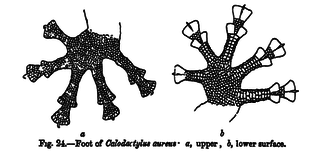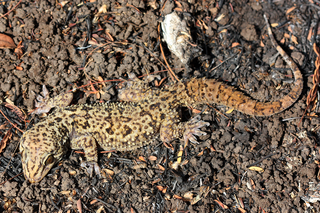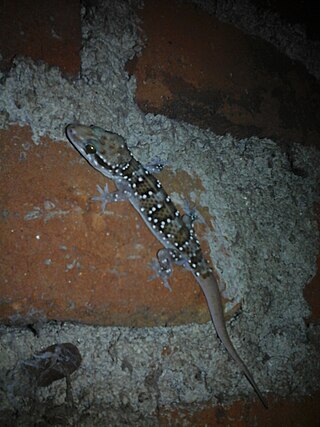
The yellow-headed day gecko, also commonly called the cheerful day gecko, Klemmer's day gecko, and the neon day gecko, is a small diurnal species of gecko, a lizard in the family Gekkonidae. This endangered species is endemic to northwestern Madagascar and inhabits coastal forests, dwelling on bamboo. The yellow-headed day gecko feeds on insects and nectar.

Hemidactylus is a genus of the common gecko family, Gekkonidae. It has 195 described species, newfound ones being described every few years. These geckos are found in all the tropical regions of the world, extending into the subtropical parts of Africa and Europe. They excel in colonizing oceanic islands by rafting on flotsam, and are for example found across most of Polynesia. In some archipelagoes, cryptic species complexes are found. Geckos like to live in and out of houses. They have been introduced to many areas around the world.

Calodactylodes is a genus of lizards, commonly called golden geckos, in the family Gekkonidae (geckos). The genus is distributed in peninsular India and Sri Lanka. Lizards in the genus Calodactylodes are primarily distinguished from other lizards by their characteristic, paired flower petal-like skin extensions on their fingers and toes.

Gehyra mutilata, also known commonly as the common four-clawed gecko, Pacific gecko, stump-toed gecko, sugar gecko in Indonesia, tender-skinned house gecko, and butiki in Filipino, is a species of lizard in the family Gekkonidae. The species is native to Southeast Asia. It has made its way to several areas of the world including Sri Lanka, Indochina, and many of the Pacific Islands. Compared to the common house gecko, the appearance of G. mutilata is somewhat plump, with delicate skin. The skin is usually colored a soft purplish/pinkish gray, with golden spots on younger specimens; these spots eventually fade with age.

Hemidactylus maculatus, also known as the spotted leaf-toed gecko or giant spotted gecko, is a species of large gecko found in the Western Ghats of India and in parts of Sri Lanka.

The rough-bellied day gecko is a species of day geckos found in the Western Ghats of India and Sri Lanka. Its distribution in the southern Western Ghats is patchy and relatively uncommon. It is active during the day. It has a distinct head, elongated snout, and keeled ventral scales; Its dark-brown dorsal side has transverse arrangement of light and dark variegations. It is pale brown/cream on its underside with spiny tubercles on its sides. Males have two to four preanal and three to six femoral pores.

The scaly gecko is a species of nocturnal, terrestrial, insectivorous gecko found in South India and northern Sri Lanka. This species was first discovered in the coastal sand dunes of Ramanathapuram in Tamil Nadu. Subsequently, it was incorrectly identified and only recently, elaborate descriptions and molecular data are available, enabling a proper identification.

Hemidactylus triedrus, also known as the termite hill gecko, Dakota's leaf-toed gecko, or blotched house gecko, is a species of gecko found in South Asia. The race lankae of Sri Lanka, is now given species status and known as Hemidactylus lankae
The Haly's tree skink is a species of lizard in the family Scincidae. The species is native to Sri Lanka. Earlier thought to be found also in the Western Ghats, taxonomic studies have shown D. haliana to be a Sri Lankan endemic, differentiated from the Indian D. subcaeruleum. D. haliana is the only arboreal skink in Sri Lanka.

Cnemaspis podihuna, also known as Deraniyagala's day gecko or dwarf day gecko is a species of diurnal gecko found only in Sri Lanka.
Cnemaspis scalpensis, commonly called Ferguson's day gecko or the rocky day gecko, is a species of diurnal gecko in the family Gekkonidae. The species is found only in Sri Lanka.
Cnemaspis kumarasinghei, commonly known as Kumarasinghe's day gecko, is a species of lizard in the family Gekkonidae. The species is endemic to the island of Sri Lanka.

Cyrtodactylus triedrus, also known as the spotted bent-toed gecko, Sri Lanka gecko, spotted bow-fingered gecko, or spotted ground gecko, is a species of gecko endemic to island of Sri Lanka.
The spotted giant gecko is a species of gecko endemic to island of Sri Lanka.

Hemidactylus lankae is a species of gecko endemic to island of Sri Lanka.
Cnemaspis gotaimbarai, or Gotaimbara's day gecko, is a species of diurnal gecko endemic to island of Sri Lanka.
Cnemaspis hitihamii, or Hitihami's day gecko, is a species of diurnal gecko endemic to island of Sri Lanka.
Cnemaspis anslemi, or Anslems' day gecko, is a species of diurnal gecko endemic to island of Sri Lanka described from northwestern foothills of Samanalawewa Nature Reserve.
Cnemaspis kotagamai, or Kotagama's day gecko, is a species of diurnal gecko endemic to island of Sri Lanka, described in 2019 from Ratnapura.












